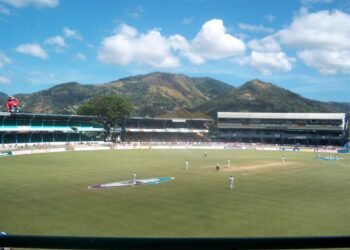Cricket, a sport celebrated for its nuances, encompasses various factors that influence the outcome of a match. Among these factors, the size of the cricket ground holds significant importance for both players and bettors alike. In this guide, we delve into the impact of ground size on cricket betting, unraveling its implications and how it shapes betting strategies.
There is a reason why some grounds are better run-scoring ones while others see bowlers take control of the situations. While some of it might be down to the pitches used, the other important factor to consider is the dimensions of the ground.
The Role of Ground Size
Cricket grounds come in diverse sizes, ranging from expansive to relatively smaller dimensions. According to the MCC, the custodians the Law of Cricket, boundaries need to be at least 65 yards (around 59.5 meters) from the bat and no more than 90 yards long.
The ICC, which borrows from these guidelines, have a 55-meter minimum guideline for the shortest boundary rule but some grounds are exempt from this because they were constructed before this guideline came into place.
This includes a cricket ground like the Eden Park in Auckland, New Zealand, which at times has a boundary length of 45 meters!
Even the former New Zealand CEO David White had slammed Eden Park for not being suitable for hosting international cricket matches because of these dimension issues.
In a submission to the Auckland city council, White had noted:
“Eden Park – the only ICC-sanctioned arena in New Zealand’s most populous city, is unaffordable for all but the biggest and, by definition, the rarest of international cricket fixtures.”
“Additionally, Eden Park’s small size and rectangular, football-shaped playing field continually risks compromising the integrity of cricket matches hosted there.”
Boundary Sizes and Scoring Opportunities
Larger grounds, like the Melbourne Cricket Ground in Melbourne, typically have longer boundaries, making it harder for batsmen to hit boundaries.
Take a look at the T20I records and as on March 1, 2024, the batting run-rate at the MCG is 7.47, which ranks outside the top 50 on the list of fastest scoring T20I cricket grounds.
Conversely, and more obviously, smaller grounds offer shorter straight and square boundaries, providing more scoring opportunities and increasing the likelihood of high-scoring matches.
Similarly, it’s no surprise that two of the shortest grounds in the world, the Eden Park in Auckland and the Holkar Stadium in Indore are the quickest scoring too.
Teams score at 8.88 RPO in T20Is held at Eden Park while the Holkar Stadium has seen a scoring rate of 6.31 RPO in ODI cricket (the highest in this format for those which have hosted at least five matches).
It makes it necessary for those betting on cricket matches to understand the boundary dimensions which in turn could help cricket bettors to anticipate the scoring trends and assess player performance accordingly.
Here’re the shortest and longest cricket grounds in the world, by boundary size:
Ground Size Could Affect Outfield & Wind Patterns
The dimensions of the ground can influence how the outfield plays.
Some of the larger grounds, if not well-maintained could get the ball scrapped up quicker because of the longer distance for which the ball remains on the surface while it’s headed to the fielder or the fence.
This could bring reverse swing into the picture, making it more difficult to score as the ball gets older.
Reverse wing is typically at play in Test match cricket, which means that the dimensions of a cricket ground could come into play for this format of the game as well.
Impact on Betting Strategies
As a result of the aforementioned reasons, other than team strengths, player form, head to head data and pitch and weather conditions, cricket punters need to look into the cricket ground dimensions as well before deciding on their strategies.
A thorough understanding of the ground dimensions allows bettors to make informed decisions when placing bets on outcomes such as total runs scored, individual player performance, and match result.
Example of Cricket Grounds and Their Characteristics
As mentioned earlier, some of the bigger grounds do not allow as high a run scoring-rate as some of those which have shorter boundaries.
Shortest Boundary Grounds (where at least one of the boundary length is quite short)
- Eden Park, Auckland
- Holkar Stadium, Indore
- Sharjah Cricket Stadium, Sharjah
- Edgbaston Cricket Ground, Birmingham
- Arun Jaitley Stadium, Delhi
- The Wanderers, Johannesburg
Longest Boundary Grounds (where at least one of the boundary length is quite long)
- Melbourne Cricket Ground, Melbourne
- Lord’s, London
- SSC Cricket Ground, Colombo
- Hagley Oval, Christchurch
- Sydney Cricket Ground, Sydney
- Basin Reserve, Wellington
Final Thoughts on the Influence of Ground Dimension on Cricket Betting
Understanding the impact of ground size is pivotal for cricket betting enthusiasts seeking to navigate the intricacies of the sport. By recognizing how ground dimensions influence gameplay and betting dynamics, bettors can refine their strategies and make more informed choices, enhancing their overall cricket betting experience.
As you venture into the world of cricket betting, remember to factor in the significance of ground size and its implications on match outcomes. By staying attuned to these nuances, you can gain a competitive edge and elevate your betting prowess in the realm of cricket.
Photo Credit: Aruna Khudan from Pixabay





